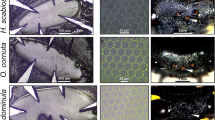Summary
Seven species of carabid beetles were examined in different “pH-Orgeln” for pH-preferences. Five of these species showed significant preferences for specific pH-fields. Presumably, this parameter of distribution found in the laboratory is also effective in the field. We caught the beetles in the field on soil of the same pH-values which they prefered in the laboratory. The pH-measurements taken by previous workers in the field match our results.
The receptors for H-ions are probably located on the antennae, because the preference distribution of Pt. angustatus changed into a uniform distribution after amputation of the distal segments of the antennae. The structure of these receptors could not be identified in electron microscope pictures (REM) among the multitude of different receptors on the antennae.
Similar content being viewed by others
References
Boer PJ Den (1960) On the Significance of Dispersal Power for Populations of Carabid Beetles (Coleoptera, Carabidae). Oecologia (Berlin) 4:1–28
Ellenberg H (1958) Bodenreaktion (einschl. Kalkfrage). Handb Pflanzenphysiol 4:638–708
Krogerus R (1939) Zur Ökologie nordischer Moortiere. Verh 7. Intern Kongr Ent Berlin 1938, 2:1213–1231
Krogerus R (1960) Ökologische Studien über nordische Moorarthropoden. Soc Scient Fennica Commentat Biol 21(3):1–238
Lindroth CH (1949) Die Fennoskandischen Carabidae. Eine tiergeographische Studie. 3. Allgemeiner Teil. Göteborgs Kungl Vetensk Vitterh-Samh Handl B 4
Mossakowski D (1966) Ökologische und biometrische Untersuchungen an epigäischen Coleopteren verschiedenartiger Moorund Heidestandorte. Diss (unpubl) Universität Kiel
Mossakowski D (1970) Das Hochmoorökoareal von Agonum ericeti (Panz.) (Coleoptera, Carabidae) und die Frage der Hochmoorbindung. Faun Ökol Mitt 3:378–392
Nettmann HK (1976) Karyotyp-Analysen bei Carabiden (Coleoptera). Mitt dtsch Ent Ges 35:113–117
Peus F (1932) Die Tierwelt der Moore unter besonderer Berücksichtigung der europäischen Hochmoore. In: Bülow Kv (ed) Handbuch der Moorkunde 3
Strenzke K (1951) Grundfragen der Autökologie. Acta Biotheoretica 9:163–184
Thiele HU (1968) Was bindet Laufkäfer an ihre Lebensräume? Naturwissenschaftl Rundschau 21:57–65
Thiele HU (1973) Physiologisch-ökologische Studien an Laufkäfern zur Kausalanalyse ihrer Habitabindung. Verh Ges Ökol Saarbrücken, 39–54
Thiele HU (1977) Carabid Beetles in Their Environment. Zoophysiology and Ecology 10, Springer, Berlin
Tischler W (1949) Grundzüge der terrestrischen Tierökologie. Vieweg, Braunschweig
Wienert U (1979) Experimentelle Untersuchungen zur Biotopbindung bei Laufkäfern (Carabidae). Staatsexamensarbeit (unpubl) Universität Bremen Fachbereich Biologie
Author information
Authors and Affiliations
Rights and permissions
About this article
Cite this article
Paje, F., Mossakowski, D. pH-preferences and habitat selection in carabid beetles. Oecologia 64, 41–46 (1984). https://doi.org/10.1007/BF00377541
Received:
Issue Date:
DOI: https://doi.org/10.1007/BF00377541




